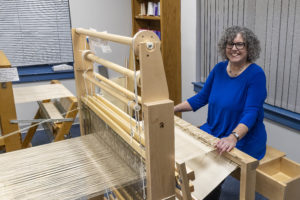
It’s been a little over a year since Kesher Israel Congregation’s weaving studio doors opened to the wider community, and the demand has shown no signs of slowing down.
The studio’s two looms have helped to churn out 16 tallitot, and its patrons have woven atarahs to don the necks of the prayer shawls and tallit bags. The wait list to access the studio is booked through November. In August, a mother and daughter duo flew in from California and spent three full days, about 25 hours total, weaving a tallit in the West Chester synagogue for the girl’s bat mitzvah.
Amateur weavers aged 12 to 77 have used the studio, with three generations of family members sometimes working on one project, which one day will become a family heirloom.
KI’s weavers owe the creation of their projects to Ilene Cetlin Lipow, the studio’s founder and a KI member for more than 30 years.
Lipow, 61, hopes the studio stays busy; she wants weaving to be an available art form to anyone in the Jewish community. After all, she knows firsthand the impact creating one’s own Judaica can have on one’s relationship with Judaism.
“It has been really rewarding to help people create something unique and special that expresses their personality or the personality of the person that they’re making it for,” she said. “It’s a great way to connect to Judaism without having to know Hebrew or going to services.”
Knitting since age 6 — taught by her grandmother — and quilting since her 20s, Lipow always had a love for the fiber arts.
She discovered weaving a decade later when attending a craft fair and took a couple of classes. By the time she was 40, she was hooked, and her husband gifted her a Swedish floor loom for her birthday. Lipow wove chuppot and tallitot for a handful of friends and family before even considering opening the KI studio.
Though Lipow studied to be a lawyer and passed the bar exam in 1985, she later became a stay-at-home mom and became an avid synagogue volunteer. She’s been the membership chair, vice president and president of KI, among other lay leadership positions.
Lipow’s relationship with Judaism was not as simple as her one with fiber arts. She grew up attending an observant synagogue with different traditions than KI.
“Sometimes women, especially in more traditional communities, sometimes feel like they can’t participate the way men do,” Lipow said. “When I grew up, women weren’t even allowed on the bimah — that I grew up in. We certainly did not wear tallitot.”
Lipow’s attitude toward her Judaism changed over time. She wove her own tallit, and weaving became a way for her to become more engaged with her Jewish roots. Since wearing a tallit and kippah, Lipow has become a regular Torah and Haftorah reader at KI.
“It’s increased my participation and my connection to my community, my connection to God by being able to do all these things,” she said.
Fiber arts have long been part of a discussion about the gendered nature of crafts, but the tides are changing, Lipow believes. While viewed for centuries as “women’s work” and taken less seriously than other art forms, fiber arts, including weaving, were art forms undertaken by men in Europe during the Middle Ages.
Today, however, Lipow has seen another shift. There are plenty of men who walk into the weaving studio interested in creating their own pieces. Men have woven tallit bags for themselves and for their young sons coming of age. One boy, still a few years from his bar mitzvah, toured the studio and plans to design and create a tallit for the milestone.
“I hope to be able to reach more men and say, ‘Hey, you can do this, too. It’s not just for the women and the girls,’” Lipow said.
Regardless of who comes into the studio, the weavers walk out with the same feeling, Lipow said. There’s gratification in having completed a large task, largely by oneself. The ritual objects created have a lasting sense of meaning to their makers.
“Honestly, the best part of this is when they’re done weaving, and we roll off the loom,” Lipow said. “I mean, people’s faces — they’re just so excited.”






